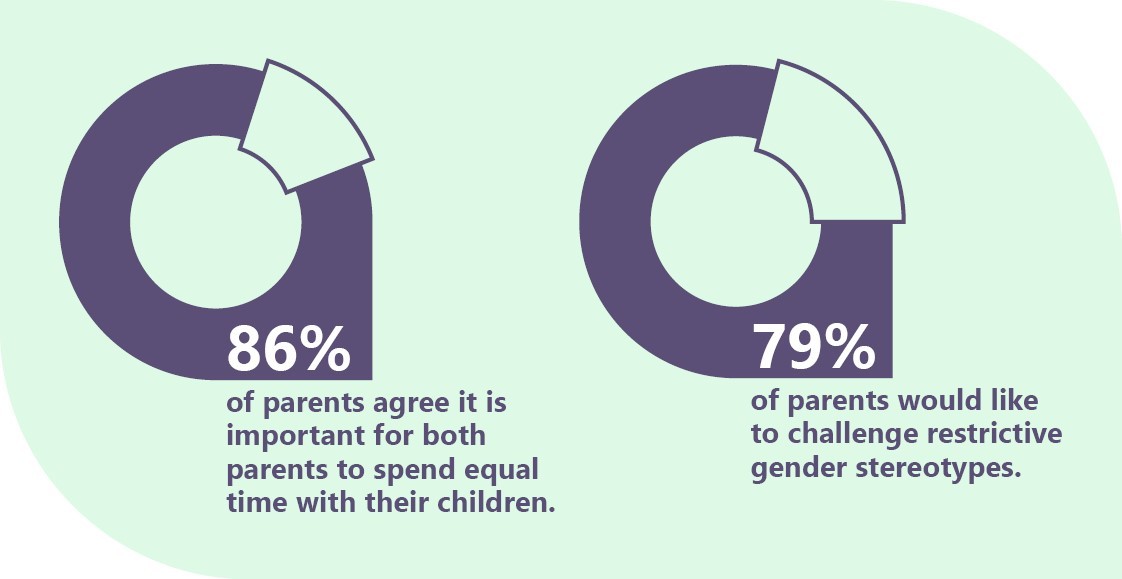While there have been changes in traditional caring roles, with increasing numbers of women entering the workforce and more gender balance in care-particularly parenting-roles, women are still overwhelmingly responsible for care. In December 2021, 54 per cent of families reported the main person looking after children was a woman, and 40 per cent of families reported equal sharing of responsibility. Only 4 per cent of families reported that a man usually or always looks after the children. Even in these cases, when asked “who plans/coordinates child activities”, it was usually or always a woman (78 per cent of the time).[15] 79.9 per cent of one parent families are single mothers.
These patterns of care are generally driven by social and economic structures that reflect and reinforce gendered care norms that frame women as primary caregivers,[16] not just for children, but also for ageing parents and people with disability. The uptake of parental leave, both Government and employer-provided, is profoundly gendered with an overwhelming number of people taking primary carers leave being women, and those taking secondary carers leave being men.[17] This pattern continues for other forms of care – in 2021 more than twice as many women than men received the Carer Payment.
In Australia the health and care workforces are highly feminised. The predominance of women in these workforces is strongly driven by gender norms and further contributes to a gender pay gap in Australia, resulting from casual, part-time work arrangements and the low pay within the sector. These factors continue to support the stereotype that care is ‘women’s work’ or work which can be done in the home and not paid. Stereotypes also hold that care work is something women do for the love of it rather than money or recognition. These stereotypes can also mean that men who do care work face discrimination about their ability to do their job.

Studies have shown paid parental leave provisions and flexible work practices are amongst the most effective policies to encourage greater participation of men in caregiving and greater equality in household dynamics.[18] Current trends in the availability and uptake of flexible working arrangements, particularly part-time and remote work, are highly gendered. This reflects current patterns of care. Women make up 67 per cent of part-time workers and are nearly three times more likely to use a flexible working arrangements to manage caring responsibilities than their partners (80 per cent compared to 28 per cent).[19] There is evidence that people who use flexible working arrangements are penalised and offered fewer opportunities for advancement, training or professional development.[20] Unless flexible working is established in a gender-equitable way and accessible to all employees, flexible work polices can inadvertently reinforce gender gaps in the access and accumulation of skills, opportunities and experience.
Women are underrepresented in leadership roles and overrepresented in casual, part time and fixed-term roles. These roles can provide flexibility to manage caring responsibilities, but are frequently lower-paid and insecure. Research shows that difficulties reconciling work and unpaid care can lead to ‘occupational downgrading’, where women choose roles below their skill levels and accept poorer conditions.[21]
Although many parents’ priorities and aspirations in relation to caring for children have changed significantly over recent decades, but parental leave arrangements have been slow to keep up with these changes, and gendered stereotypes and expectations in the way that we work can limit take up of leave arrangements when they are available. It may also leave parents feeling they may not have the choice to care differently, including fathers who are not supported to take on care roles.
Workplaces benefit from strategies supporting all employees to better manage family and caring responsibilities. Employer-provided paid parental leave is a crucial element in supporting women to stay in the workforce. Female managers are twice as likely to return to work if their employer provides 13 or more weeks of paid parental leave. Companies with formal support policies for flexible work increased their share of part-time female managers by 7.5 percentage points.[22]
Women in Australia face a ‘motherhood penalty’, in which mothers experience a significant financial setback due to both reduced working hours and time out of the workforce. Women’s earnings are reduced by an average of 55 per cent in the first five years of parenthood. This penalty continues through the first decade after childbirth. While women face penalties in the workforce for parental responsibilities, men are rewarded. Indeed, men experience a “fatherhood premium” of approximately 7.3 per cent.[23]
Research by the Grattan Institute using data from the 2017 HILDA Survey estimated that an average 25 year old woman with children will earn around $2 million less over her lifetime than an average 25 year old man with children, and nearly $1 million less than an average woman without children.[24]
Prompt
What are the underlying challenges in the way we value and allocate care that the strategy could address?
[15] Australian Institute of Family Studies 2022 Conference Proceedings (paperlessevents.com.au)
[16] For further information: Our Watch (2018) Challenging gender stereotypes in the early years: the power of parents, Melbourne.
[17] Deloitte Access Economics Breaking the norms: Unleashing Australia’s economic potential, Report prepared in partnership with Australians Investing in Women, November 2022.
[18] Deloitte Access Economics, (2022) Breaking the norms: Unleashing Australia’s economic potential, Report prepared in partnership with Australians Investing in Women, November 2022
[19] CEW and Bain & Company, Equitable Flexibility.
[20] CEW and Bain & Company, Equitable Flexibility.
[21] Hegewisch and JC Gornick, ‘The impact of work-family policies on women’s employment: a review of research from OECD countries’, Community, Work and Family, 2011, 14(2):119–138, doi.org/10.1080/13668803.2011.571395.
[22] R Cassells and A Duncan, Gender Equity Insights 2019: Breaking through the glass ceiling, Bankwest Curtin Economics Centre, 2019.
[23] Bahar E, Bradshaw N, Deutscher N and Montaigne M (2022) Children and the Gender Earnings Gap, Treasury Round Up, October 2022.
[24] D Wood, K Griffiths and O Emslie, Cheaper childcare: A practical plan to boost female workforce participation, Grattan Institute, 2020.
